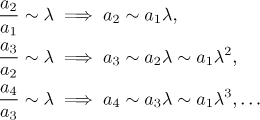Theorem (Root test - limit version).
Consider a series
![]()
converges.
• If
• If
There is one type of a series that we know quite well - the geometric series. Thus it can be very helpful if we learn that a given series is similar to a geometric series. The Root test and the Ratio test are at their hearts two ways to recognize such similarity. We first show the most popular type of these two - the limit version.
Theorem (Root test - limit version).
Consider a series∑ ak such thatak ≥ 0 for all k. Assume that the limit
converges.
• Ifϱ < 1 then the series converges.
• Ifϱ > 1 then the series diverges.
It is also called D'Alambert's test. Why does it work in this way? The limit result says that for really large k we essentially have
![]()
So a series that satisfies the assumption of this test really looks like a
geometric series (for large k, that is, at its end, but we know that
convergence is decided at the end of a series). Now the conclusion should be
obvious (or at least believable). What about the case
Theorem (Ratio test - limit version).
Consider a series∑ ak such thatak > 0 for all k. Assume that the limit
converges.
• Ifλ < 1 then the series converges.
• Ifλ > 1 then the series diverges.
It is also called Cauchy's test. Why does it work in this way? The limit result says that for really large k we have
![]()
Here it is not as obvious as in the case of the Root test. For simplicity assume that the approximation in the limit works for all k, not just for the large ones, then we can go like this:

Again, notice that the case when lambda is 1 remains unsolved. However, here one can get some help from a more sophisticated test, see the Raabe test in the section Theory - Testing convergence - More tests.
Example: Investigate the convergence of
![]() .
.
We apply the Root test.
![]()
(For the limit of
We will try to independently confirm this conclusion by applying the Ratio test.

Since
Note also that the two constants in the Root test and in the Ratio test came up equal. This is always true (that is, when both tests can be used) and it is not really surprising. Each tests essentially answers the question "to which geometric series is this one similar", and the same series cannot be similar to two different geometric series. Theoretically, the Root test is "stronger" in the following sense: If the limit for λ converges, then also necessarily the limit for ϱ converges (and to the same number). Thus, theoretically, if the Ratio test works, we can always do the Root test instead. On the other hand, there are series for which the limit for ϱ converges but the limit for λ doesn't and the Ratio test cannot be used. However, this only talks about theoretical convergence, finding limits in practice may be another story. There are cases where applying the Ratio test is simple but the limit for the Root test is a real killer.
When using the Root test one often uses the fact that the k-th root of k goes to 1. It can be generalized as follows.
Fact.
Consider a non-zero polynomialp(x). Then
From practical point of view this means that when a series is based on polynomials, then usually the Root test and the Ratio test do not give us anything about its convergence. What really works well with these two tests are series that feature expressions of the form 2k, as we saw above. For hints on choosing the best test see Methods Survey - Testing convergence.
The limit versions of the two tests that we saw above are simple to use, but they are not the strongest available. There are cases when they fail not because they yield 1, but even before we get there. We know that not every sequence has a limit, so it may happen that we do not even get any rho or lambda. We will show two ways to fix it.
There is a notion of a limit that is more general, so-called "limes
superior". It is known that every sequence
On the other hand, only the first statement - about convergence - can be done using limsup in the Ratio test. So this is still useful, but not as elegant. For precise statements see this note.
Probably the most elegant and at the same time the most general versions of these test prefer to look at terms as individuals, not through some limit notion.
Theorem (Root test).
Consider a series∑ ak such thatak ≥ 0 for all k.
• If there isϱ < 1 and an integer N such thatfor all
k > N, then the series converges.
• Iffor infinitely many k, then the series diverges.
What case remains indeterminate? If the terms
Theorem (Ratio test).
Consider a series∑ ak such thatak > 0 for all k.
• If there isλ < 1 and an integer N such thatfor all
k > N, then the series converges.
• If there is an integer N such thatfor all
k > N, then the series diverges.
If you are curious about relationship between this "inequality" approach and "limsup" approach, check out this note.
For more information see Root test and Ratio test in Methods Survey - Testing convergence and also Solved Problems - Testing convergence. Namely, typical situations of using the Root test can be found in this problem, this problem, this problem, and this problem, check out also this problem. For the Ratio test check out this problem, this problem, this problem, this problem, and this problem, try also this problem.
Note about general series:
If a given series
If
It is easy to show that if